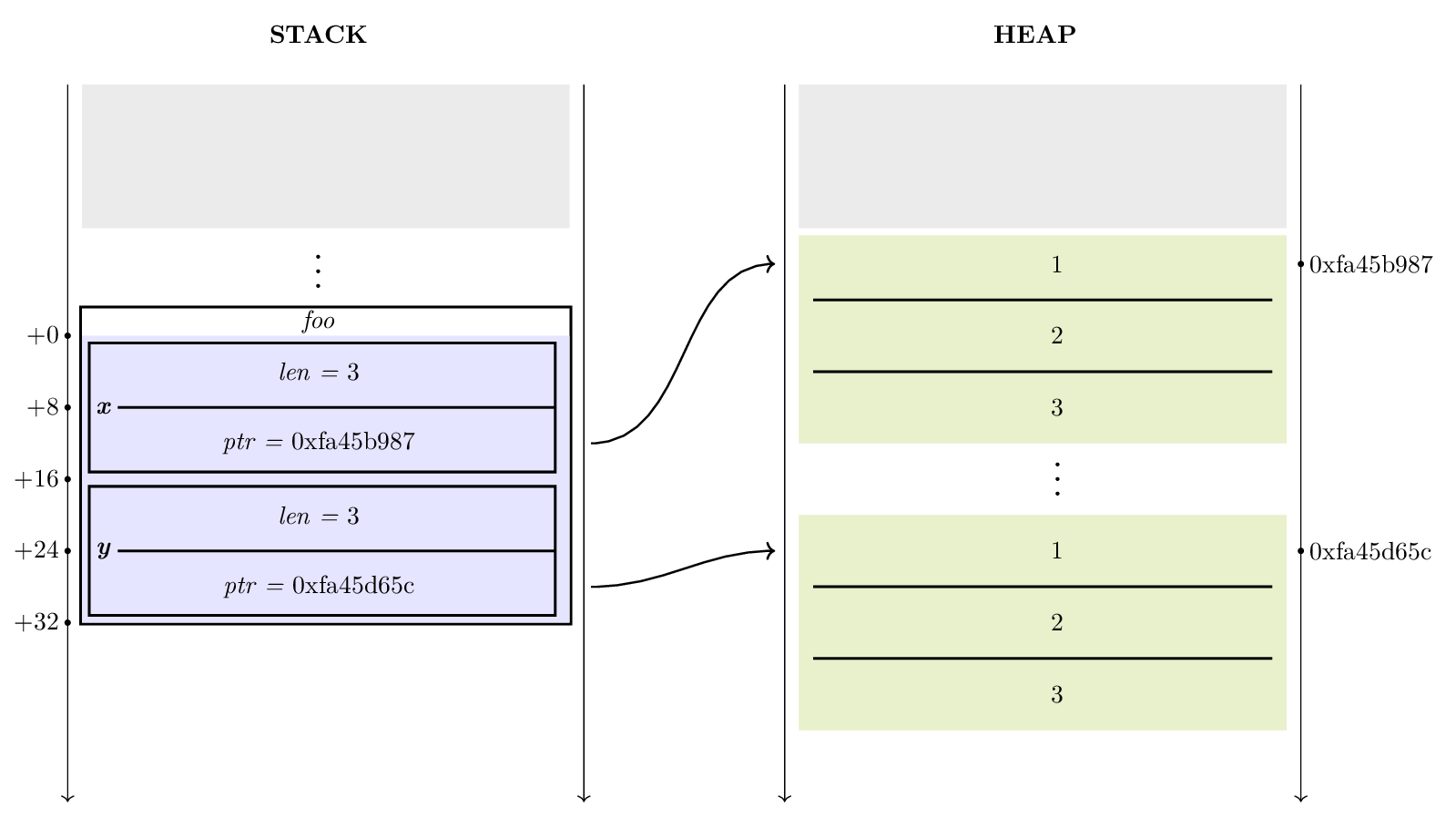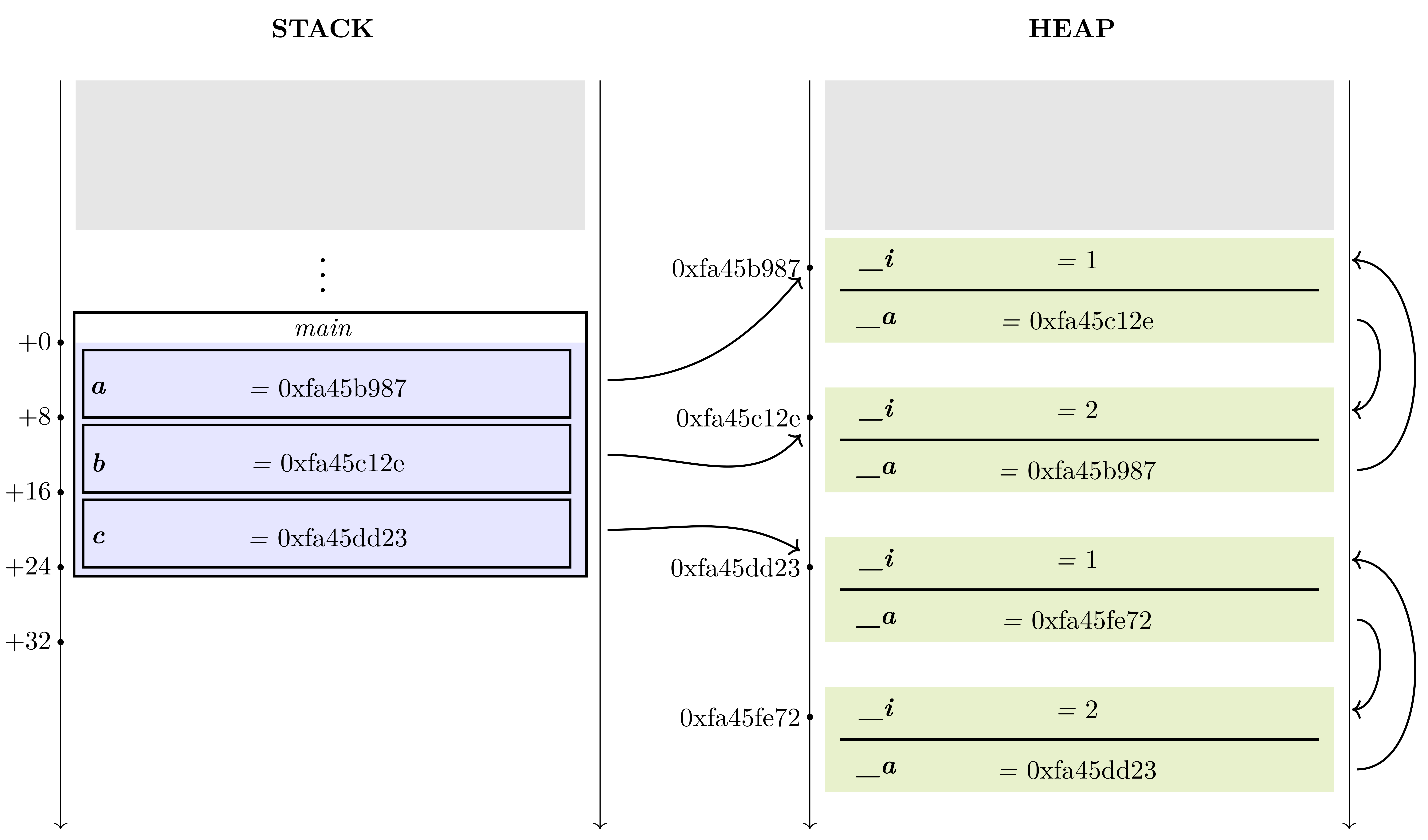1. Copy data to make them mutable
Sometimes it is not possible to allow data to be borrowed by foreign
functions or variables. This can be due to the facts that data are
immutable for example. To solve this problem, Ymir provides two
keywords, copy and dcopy.
1.1. Copy
The copy keyword makes a copy of the first level of a value,
whose type is aliasable. This copy transform an immutable type into a
mutable one, by increasing its mutability level by one. The following
table shows some examples of the types of copied values :
| Type | Type of copied value |
|---|---|
| [i32] | mut [mut i32] |
| mut [i32] | mut [mut i32] |
| mut [[i32]] | mut [mut [i32]] |
An example of what can be achieved by copy keyword is shown in
the following code. The representation of the memory is also shown in
the figure underneath. In this example, the variable x is copied
and the result value is placed in the variable y. In this
example, each variable are borrowing different data placed on the
heap, whose values are equivalent.
import std::io
def main ()
throws &AssertError, &OutOfArray
{
let x = [1, 2, 3];
let dmut y = copy x; // create a copy of x
assert (x == y); // y and x have the same value, but at different location
y [0] = 9;
assert (x == [1, 2, 3]); // modifying y does not affect x
assert (y == [9, 2, 3]); // but still affects y
}
We can see from the figure below, that the variable y points to
data at a different location, from the data pointed by x. This
implies a new memory allocation, and a memory copy, that cost some cpu
time, and memory place. For that reason, copies are never hidden by
the language, and are made only when the keyword copy is placed
in the source code.

Exercise : Modify x that is initialised with an imutable string literal :
import std::io
def main ()
throws &OutOfArray
{
let x = "hello !";
x [0] = 'H'; // Make this line work
assert (x == "Hello !");
}
1.2. Deep copy
The deep copy will make a copy of the value and all internal values, it must be used in special cases because it is much less efficient than the simple copy, which copies only one level of the data. There is nothing complex to understand in deep copy, it simply creates a value, deeply mutable, which is an exact copy.
import std::io
def main () {
let x = [[1], [2, 3], [4]];
let dmut y = dcopy x;
let mut z : [mut [i32]] = copy x;
println (x, " ", y, " ", z);
}
The structure of the copy respect the structure of the initial value that has been copied, meaning that even recursive values can be copied without any worries. To make recursive values, we need to use objects, that are described in the chapter Objects, and traits described in the chapter Traits to make the objects deeply copiable. To avoid the scattering of the information, we will assume that you will have already read these chapters and came back here to understand the deep copy on objects.
In the following example, the object A contains a field of type
A. The initialization of this field is made using the either
self or another object in the constructor defined at line
1 and 2. Thus the state of the memory in the main
function, at line 1 can be described by the figure depicted just
underneath the source code.
import std::io;
class A {
let _i : i32;
let dmut _a : &A;
pub self (i : i32, dmut a : &A) with _a = alias a, _i = i {
self._a._a = alias self;
}
pub self (i : i32) with _a = alias self, _i = i {}
impl Copiable, Streamable; // to make A deep copiable, and printable
}
def main () {
let dmut a = A::new (1);
let dmut b = A::new (2, alias a);
println (a);
println (b);
}
Results:
main::A(1, main::A(2, main::A(...)))
main::A(2, main::A(1, main::A(...)))
Memory state at line 20 :

Now let's add a deep copy of the value contained inside the variable
a into a variable c. This deep copy copies the values of
the object inside a, and the object inside the field _a,
the copy is recursive, and correctly keeps the structure.
let c = dcopy a;
The following figure represents the memory state of the program after the deep copy.
